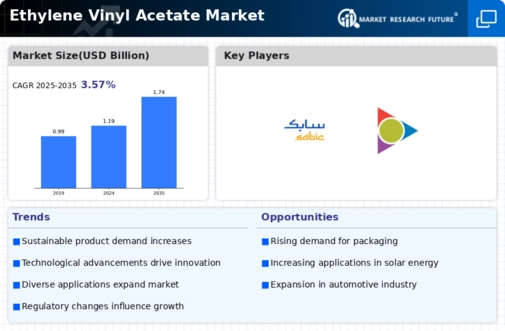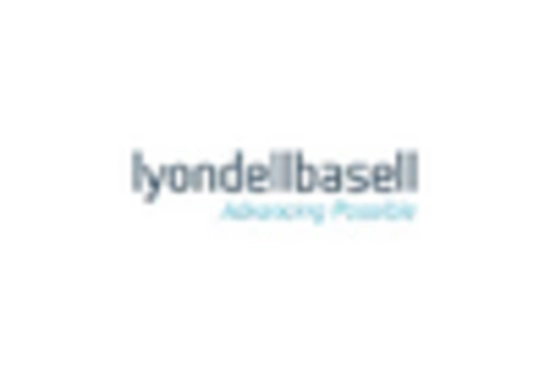Growth in Footwear Industry
The Ethylene Vinyl Acetate Market is significantly influenced by the expanding footwear sector. Ethylene vinyl acetate is widely utilized in the production of shoe soles and insoles due to its lightweight nature and cushioning properties. In recent years, the footwear industry has seen a robust growth trajectory, with a projected increase in demand for comfortable and durable footwear. This trend is expected to continue, as consumers increasingly prioritize comfort and performance in their footwear choices. The versatility of ethylene vinyl acetate allows for innovative designs and enhanced functionality, which could further drive its adoption in the footwear market. As a result, the footwear segment is anticipated to contribute substantially to the overall growth of the ethylene vinyl acetate market.
Rising Demand in Packaging Sector
The Ethylene Vinyl Acetate Market is experiencing a notable surge in demand, particularly within the packaging sector. This increase is largely attributed to the material's excellent clarity, flexibility, and resistance to UV radiation, making it an ideal choice for various packaging applications. In 2025, the packaging segment is projected to account for a substantial share of the market, driven by the growing need for lightweight and durable packaging solutions. Furthermore, the shift towards sustainable packaging options is likely to enhance the appeal of ethylene vinyl acetate, as it can be produced with a lower environmental impact compared to traditional materials. As consumer preferences evolve, manufacturers are increasingly adopting ethylene vinyl acetate to meet the rising expectations for quality and sustainability in packaging.
Expansion of Renewable Energy Sector
The Ethylene Vinyl Acetate Market is also influenced by the expansion of the renewable energy sector, particularly in the production of solar panels. Ethylene vinyl acetate is commonly used as an encapsulant in photovoltaic modules, providing protection and enhancing the durability of solar cells. As the global push for renewable energy sources intensifies, the demand for solar energy solutions is expected to rise significantly. This trend is likely to create new opportunities for the ethylene vinyl acetate market, as manufacturers seek reliable materials to ensure the longevity and efficiency of solar panels. The intersection of renewable energy and ethylene vinyl acetate applications could lead to a substantial increase in market growth in the coming years.
Technological Innovations in Production
The Ethylene Vinyl Acetate Market is benefiting from ongoing technological innovations in production processes. Advances in polymerization techniques and the development of new catalysts are enhancing the efficiency and quality of ethylene vinyl acetate production. These innovations not only reduce production costs but also improve the material's properties, making it more appealing for various applications. As manufacturers strive to optimize their processes, the introduction of more sustainable and efficient production methods is likely to play a crucial role in shaping the market landscape. The ability to produce high-quality ethylene vinyl acetate at competitive prices could lead to increased market penetration across diverse sectors, thereby driving overall growth.
Increasing Use in Automotive Applications
The Ethylene Vinyl Acetate Market is poised for growth due to the rising utilization of ethylene vinyl acetate in automotive applications. This material is favored for its excellent adhesion properties and resistance to extreme temperatures, making it suitable for various automotive components, including interior and exterior parts. The automotive sector is undergoing a transformation, with manufacturers increasingly focusing on lightweight materials to improve fuel efficiency and reduce emissions. Ethylene vinyl acetate's lightweight characteristics align well with these objectives, suggesting a potential increase in its adoption within the industry. As the automotive market continues to evolve, the demand for ethylene vinyl acetate is likely to rise, further bolstering the market's expansion.


















Leave a Comment